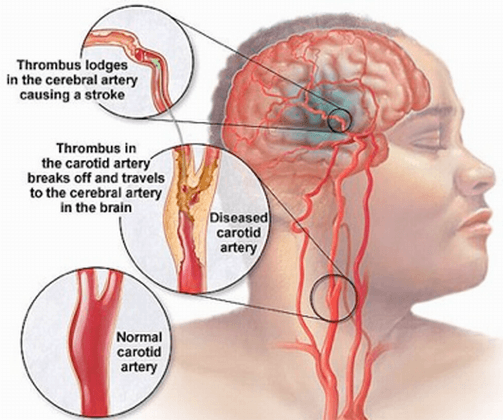What's in this article?
What Is Carotid Artery Disease?
Carotid (ka-ROT-id) artery disease is a disease in which a waxy substance called plaque (plak) builds up inside the carotid arteries. You have two common carotid arteries, one on each side of your neck. They each divide into internal and external carotid arteries.
The internal carotid arteries supply oxygen-rich blood to your brain. The external carotid arteries supply oxygen-rich blood to your face, scalp, and neck.
Carotid artery disease is serious because it can cause a stroke, also called a “brain attack.” A stroke occurs if blood flow to your brain is cut off.
If blood flow is cut off for more than a few minutes, the cells in your brain start to die. This impairs the parts of the body that the brain cells control. A stroke can cause lasting brain damage; long-term disability, such as vision or speech problems or paralysis (an inability to move); or death.
What are the symptoms?
Carotid artery disease may not cause symptoms in its early stages.
Unfortunately, the first sign of carotid artery disease could be a stroke. However, you may experience warning symptoms of a stroke called transient ischemic attacks, or TIAs. Symptoms of a TIA usually last for a few minutes to 1 hour and include:
- Feeling weakness, numbness, or a tingling sensation on one side of your body, for example, in an arm or a leg
- Being unable to control the movement of an arm or a leg
- Losing vision in one eye (many people describe this sensation as a window shade coming down)
- Being unable to speak clearly
These symptoms usually go away completely within 24 hours. However, you should not ignore them. Having a TIA means that you are at serious risk of a stroke in the near future. You should report TIA symptoms to your physician immediately.
If you experience the above symptoms for longer than a few hours, or they don’t resolve within 24 hours, a stroke has probably occurred. You should contact your physician immediately.
How is carotid artery disease diagnosed?
In most cases, the disease can be detected during a normal checkup with a healthcare professional, who might order the following tests:
- History and physical exam: A healthcare professional may use a stethoscope to listen for a rushing sound, called a bruit (pronounced “brew-ee”), in a carotid artery. This tactic is not guaranteed to identify the disease. Some low-risk blockages can make a significant sound but high-risk blockages can be soundless.
- Doppler ultrasound imaging: This painless, noninvasive test is conducted by sending sound waves above the range of human hearing into the neck. Echoes bounce off the moving blood and the tissue in the artery and be formed into an image.
- Oculoplethysmography (OPG): This procedure measures the pulsation of the arteries in the back of the eye. It is used as an indirect check for blockages in the carotid arteries.
- Computed tomography (CT) Scan: This test produces a series of cross-sectional X-rays of the head and brain. It cannot detect carotid artery disease but may be ordered to investigate other possible causes of stroke symptoms.
- Arteriography and Digital Subtraction Angiography (DSA): Arteriography is an X-ray of the carotid artery taken when a special dye is injected into another artery in the leg or arm. DSA is also an X-ray of the carotid artery. It is similar to arteriography except that less dye is used. These invasive procedures carry their own small risk of causing a stroke.
- Magnetic Resonance Angiography (MRA): This technique is more accurate than ultrasound, yet avoids the risks associated with X-rays and dye injection. An MRA is a type of magnetic resonance image (MRI) that uses special software to create an image of the arteries in the brain.
Controllable Risk Factors Carotid Artery Disease
Carotid artery disease (also called carotid artery stenosis) is the narrowing of the carotid arteries, the two main blood vessels in the neck that supply blood to the brain. Age, unhealthy lifestyle and not effectively managing stroke risk factors such as high cholesterol can lead to carotid artery disease. Plaque, often caused by cholesterol deposits, and other fatty substances can lead to the narrowing and in some cases complete blockage of an artery. Narrowed and blocked arteries can lead to stroke.
What Are the Risk Factors for Carotid Artery Disease?
The risk factors for carotid artery disease are similar to those for other types of heart disease. They include:
- Age
- Smoking
- Hypertension (high blood pressure)
- Abnormal lipids or high cholesterol
- Diet high in saturated fats
- Insulin resistance
- Diabetes
- Obesity
- Sedentary lifestyle
Men younger than age 75 have a greater risk than women in the same age group. Women have a greater risk than men older than age 75. People who have coronary artery disease have an increased risk of developing carotid artery disease. Typically, the carotid arteries become diseased a few years later than the coronary arteries
What other surgery can help with carotid artery disease?
Arterial bypass surgery does not help prevent stroke, but can re-establish blood flow when a carotid artery is blocked. Surgeons make a hole in the cranium and connect an artery serving the face or head to an artery serving the brain.





